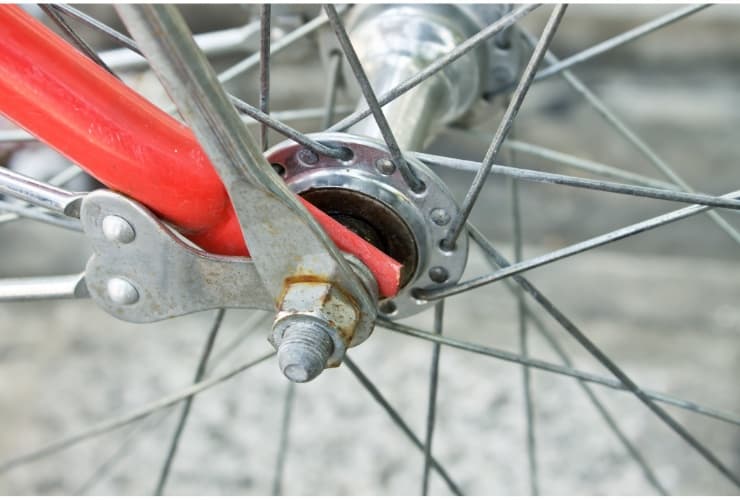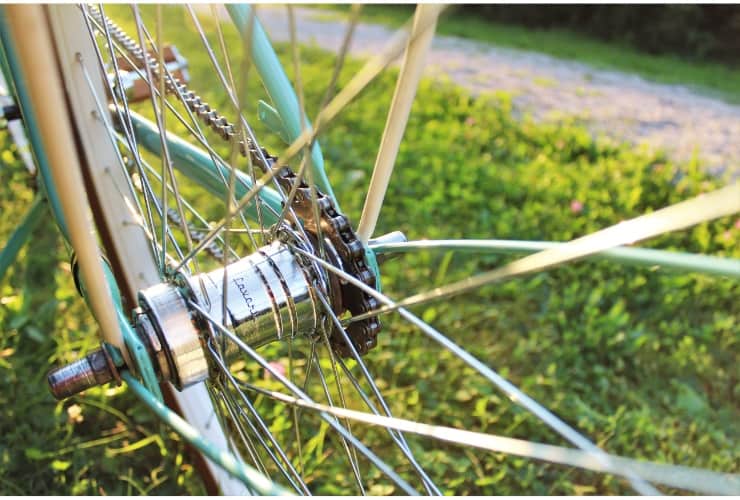If you’re an avid cyclist, you’ve probably had a few broken spokes throughout your career. Whether you were about to hop on your bike or were in the middle of a ride, you were probably wondering if it was safe to continue. Can you ride a bike with a broken spoke?
This article will tell you everything you need to know, including how to ride safely with broken spokes. I will also explain how to fix this issue in five easy steps. Let’s get started.
Key Takeaways
- Signs of broken spokes include a wobbly wheel, empty spaces where spokes used to be, loose spokes, and signs of deterioration like rust or thinning.
- Riding with a single broken spoke is generally safe, but if multiple spokes are missing or dangling, it could lead to bike damage and more spokes breaking.
- When riding with a broken spoke inspect the damage, secure the spoke with adhesive like duct tape, keep checking the spoke’s condition during the ride, and consider stopping if it keeps coming loose.
- Common reasons for broken spokes include wear and tear over time, infrequent maintenance, and exposure to rough terrain that can lead to damage or deterioration.
- Regular inspection for signs of damage, tightening spokes using proper tools, and cleaning spokes to prevent rust buildup are essential maintenance practices.
What Are Bike Spokes Actually for (and Why Do They Matter)?
Before you learn more about broken spokes and whether you can ride with them, you should first understand what they are.
Spokes are long, skinny rods that connect the bike hub with the rim. Their main purpose is to help balance and distribute the rider’s weight between those two parts. They also help to transfer leg power to the bike’s rim, which keeps the bike moving forward.
Bike spokes also help to increase the wheel’s strength without being vulnerable to wind and can increase shock resistance and maneuverability.
Identifying a Broken Spoke
There are a few ways to identify broken spokes, which I will list below. It’s important to be mindful of these signs so you can catch a broken spoke right away.
- Wobbly wheel. The first and most common sign that a spoke is broken is that your wheel will feel wobbly. While you probably won’t hear the spoke snapping, as it usually happens while riding, you will feel a difference in your wheel.
- Empty space between other spokes. The most obvious sign of a broken spoke is an empty spoke nipple on the rim where a spoke used to be. This sign typically means that you have a spoke missing and that it fell off sometime while riding.
- Loose spoke. Sometimes you’ll notice a loose spoke, meaning that one end is still attached to the rim while the other end of the spoke is dangling. A loose spoke will be easy to spot.
- Signs of deterioration. A less obvious sign of a damaged spoke is deterioration. When you inspect your wheel, look out for rust. Some spokes may also become thinner and wear down due to elements like weather and rough terrain.

Is It Safe to Ride a Bike with a Broken Spoke?
So, are broken spokes dangerous to ride with? While riding with a broken spoke may introduce some safety hazards, many cyclists still ride with broken or damaged spokes.
It won’t be too dangerous to ride your bike unless there are multiple missing or dangling spokes. The bigger problem is that you may damage your bike if you continue riding in this condition. It could also lead to more spokes breaking.
The worst that can happen is your wheel buckles or completely falls off. This is why you should assess the severity of the damage before you continue riding.
Ultimately, when you ride with damaged or broken spokes, pressure will build on the other spokes. Riding long enough in this condition can lead to long-term damage that could be costly to repair.
How to Ride With a Broken Spoke
Now that you know you can ride with a broken spoke, there are a few things to keep in mind that will help your ride to go smoother. Take a look at the list below for some tips.
- Assess damage. First of all, you need to make sure that the damage isn’t severe. Assess your rim to make sure there aren’t multiple spokes missing. You should avoid riding your bike if three or four spokes are missing or damaged.
- Secure the spoke. Most of the time, a broken spoke hangs loose from the rim or hub. Loose spokes are dangerous to ride with, so you’ll have to secure the bike spoke with some sort of adhesive. If you carry tape with you, duct tape works great for this. You can also simply twist it around an adjacent good spoke if you don’t have adhesive.
- Keep an eye on the spokes as you ride. You won’t have to worry about this if the broken spoke is completely gone. However, if you’ve secured a loose spoke, keep checking the spoke as you ride to ensure it stays secure and stop cycling if it keeps coming loose.
How to Replace a Broken Spoke
If you’re used to spokes breaking or have noticed a missing spoke for the first time, you’ve come to the right place. In this section, I will explain how to replace a broken spoke in a few easy steps.
Tools Needed
- New spoke and spoke nipple
- Magnetic screwdriver
- Chain whip
- Spoke key
- Torx key (T25)
- Bottom bracket tool
Step-by-step Guide
- Remove the cassette. If you’re working on the back wheel, remove the cassette first. You can skip this step if you’re working on the front wheel.
- Take off the brake rotor. Depending on your bike model, you’ll either need to use the torx key or bottom bracket tool for this step. Use these tools to remove the bolts or lockring and then remove the brake rotor.
- Remove the spoke nipple. This step will only be necessary if the nipple is damaged or the spoke snapped near or inside it. To remove the spoke nipple, first remove the rim strip and tire. You can use the magnetic screwdriver to take the nipple out.
- Remove the spoke. If only the spoke is damaged, all you have to do is unwind it using a spoke key. After unwinding it, simply replace it with a new spoke, threading it to the nipple.
- Tighten the new spoke. Once the spoke is threaded, you must tighten it with a spoke key. Be careful not to put too much stress on the nipple.
Most Common Causes of Damage
While I cover prevention strategies below, being aware of the most common reasons spokes break will also help prevent damage.
Typical Wear and Tear
When it comes to broken spokes, the most common reason they break is simply wear and tear. Even if you take care of your bike, you’ll eventually need replacement spokes; this doesn’t mean you failed to take care of your bike. Even with the best care, time and use will take their toll.
Infrequent Maintenance
Another common reason for broken spokes is infrequent maintenance. You don’t need to be a bike mechanic to take care of your bike properly; simply follow the tips below to prevent broken spokes.
Properly maintaining your bike will help avoid things like rust, loose spokes, and dirt build-up. All of these things can eventually lead to broken spokes.
Rough Terrain
Sometimes all it takes for a spoke to be damaged is rough terrain; a big pothole or jump can easily lead to a broken spoke. Furthermore, rough terrain will wear out your bike rims more quickly, which can lead to deterioration. This is more likely to happen if you ride a mountain bike.
How to Maintain Bike Spokes
Maintaining your bike may seem annoying and inconvenient, but it will help prevent costly repairs. This section will review key prevention strategies to help ensure a smooth ride every time.
Inspect Wheels Regularly
The first and most important maintenance tip is to inspect your wheels regularly. It’s easy to forget about this step, and before you know it, you have several broken spokes on your hands. After every couple of rides, inspect all the spokes for signs of damage.
Some things to look for on the individual spokes are rust, thinning, or any type of wear and tear. Furthermore, quickly scan the rim to see if you spot an empty spoke nipple.
Tighten Spokes
If you take your bike to your local bike shop now and then, you can always ask them to do this for you. However, knowing how to tighten your spokes is a useful skill to have.
To adjust spoke tension, you’ll need a bike spoke tightener or a spoke wrench. These tools should work with most bikes, whether you have a road bike or a mountain bike.
These are relatively small tools that you can easily keep in bike repair kits. Once you’ve found the broken spoke, place the tool on the spoke nipple and turn it clockwise to increase spoke tension.
Clean Spokes Regularly
It can be easy to ignore your bicycle spokes if they seem to be in good condition. However, regularly cleaning them will help decrease the times you need to buy replacement spokes. Refer below for a quick cleaning checklist.
- Remove dirt from each spoke. First, you’ll need to wipe each spoke individually with a wet rag. This will remove most of the dust and dirt, helping anti-rust spray work more effectively.
- Use anti-rust spray. Wearing a mask and gloves, apply a layer of anti-rust spray. Let the spray sit for a minute, then use steel wool to wipe the spokes and scrub off the rust.
- Clean leftover rust. After applying the anti-rust spray, there may be some leftover debris and rust on the bike’s wheels. Make a solution of warm water with some dish soap, and use the steel wool again to clean each bicycle spoke.
- Rinse and dry spokes. Rinse the spokes with water and dry each spoke with a cloth. Use the warm water and dish soap solution again if you see any small rust remnants. Even a small speck can spread to more spokes.
- Apply wax. Once everything is dry, apply wax to all the wheel spokes. This will create a barrier and prevent rust from forming. By the end of this process, your wheels will look like new.
Conclusion
When determining whether it’s safe or not to ride with a broken spoke, the main determining factor is the number of broken spokes. Avoid riding if there are over three broken spokes. You’ll not only have trouble riding, but this could introduce some safety hazards.
If you have one or two broken spokes, simply secure the spoke and keep an eye on it as you ride.
Make sure to share this article if you enjoyed it, and leave a comment on how you keep your bike wheels in tip-top shape!

